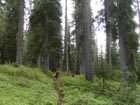
Subalpine forest dominated by Picea engelmannii in the Entiat Valley, Washington [C.J. Earle, 2004.07.02].
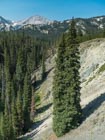
A pair of mature, open-grown trees in the White Cloud Mtns. of Idaho [C.J. Earle, 2017.08.22].

A "skirted" tree in the Medicine Bow Mtns. of Wyoming. The low "skirt" spends the winter buried within the snowpack; the bare stems just above are zones where blowing ice crystals, bouncing along the snowpack, abrade and kill any exposed foliage; and the foliage farther above the snow surface is protected from winter abrasion by formation of rime [C.J. Earle, 2006.06.30].

A krummholz mat of P. engelmannii containing a small krummholz Pinus albicaulis; Golden Horn, Washington [C.J. Earle, 2015.07.05].

Krummholz mats showing frost damage from the prior winter; Middle Tiffany Mtn., Washington [C.J. Earle, 2000.07.21].
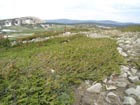
A very extensive krummholz mat, largely propagated through layering, in the Medicine Bow Mtns. of Wyoming. The foliage shows some frost damage from the prior winter. The background forest, all the way to the horizon, consists almost exclusively of Abies lasiocarpa and Picea engelmannii [C.J. Earle, 2006.07.01].
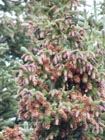
Two successive years of heavy cone crops on a mature tree at Tiffany Mtn., Washington [C.J. Earle, 2003.08.16].
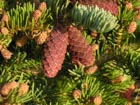
Young, fertile seed and pollen cones. Seed cones on a tree typically become fertile before the pollen cones, as a defense against self-fertilization [C.J. Earle, 2006.07.03].
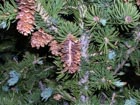
A squirrel created this cross-sectional view of a ripe seed cone [C.J. Earle, 2006.06.30].
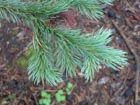
Shade foliage in P. engelmannii is not 2-ranked, but assumes this "brushed" appearance in contrast to the morphology of sun foliage shown in the above photo [C.J. Earle, 2006.07.04].
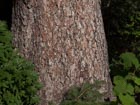
Bark on a tree about 70 cm diameter [C.J. Earle, 2013.07.24].
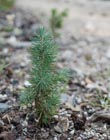
Seedling about 10 cm tall, probably at least 2 years old [C.J. Earle, 2017.08.19].
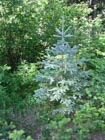
Some specimens are exceptionally glaucous, and have given rise to cultivars sold as "blue spruce" (which is a different species, Picea pungens) in the horticultural trade [C.J. Earle, 2003.07.04].
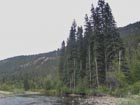
Although usually thought of as a tree of the high mountains, P. engelmannii has an alternative role as a riparian forest tree. It is well adapted for this niche due to its tolerance of very wet soils and low temperatures (cold air drainage being a factor in many mountain valleys) and its relative intolerance for fire: riparian forests are seldom burned. This small riparian stand is in the Okanogan Mountains of Washington [C.J. Earle, 2003.08.15].

Picea engelmannii
Parry ex Engelmann 1863
Common names
Engelmann spruce, silver spruce, white spruce, mountain spruce (Peattie 1950), épinette d'Engelmann (Canadian French), pino real (Spanish) (Taylor 1993).
Taxonomic notes
Two subspecies, engelmannii (described here) and mexicana. Synonymy for var. engelmannii (Taylor 1993):
- Picea glauca (Moench) Voss subsp. engelmannii (Parry ex Engelmann) T.M.C. Taylor;
- P. columbiana Lemmon;
- P. engelmannii var. glabra Goodman.
There are two hybrids, or nothospecies, where P. engelmannii overlaps with related spruces. The hybrid with P. glauca to form Albert or interior spruce, P. × albertiana S. Br. (syn. P. glauca var. albertiana (S. Br.) Sarg. 1919) (Taylor 1993). In the Chilliwack River Valley of British Columbia, P. engelmannii hybridizes with P. sitchensis; the hybrid has not been formally described. The area is near sea level and the Fraser Valley, yet comes right out of the heart of the North Cascades. This hybrid may occur elsewhere, where the species' ranges are contiguous (such as the Federation Forest/Crystal Mountain area of Washington) but has not been seen yet (email, Robert Van Pelt, 1999.07.22). All three species (P. engelmannii, glauca, and sitchensis) hybridize in a zone in the interior Skeena River valley in British Columbia (Sutton et al. 1994).
Description
Trees to 60 m tall and 200 cm dbh, with a narrowly conical crown. Bark gray to reddish brown. Twigs stout, yellow-brown, finely pubescent, occasionally glabrous. Buds orange-brown, 3-6 mm, apex rounded. Leaves 1.6-3(3.5) cm long, 4-angled in cross section, rigid, blue-green, bearing stomates on all surfaces, apex sharp-pointed. Seed cones violet or deep purple, ripening buff-brown, 3-7(8) cm long; scales diamond-shaped to elliptic, widest above middle, 13-20 × 9-16 mm, flexible, margin at apex irregularly toothed to erose, apex extending 3-8 mm beyond seed-wing impression. 2n=24 (Taylor 1993).
P. × albertiana has unusually prominent leaf bases, cones nearly as broad as long, cone scales acute and broader than long, and an unusually narrow crown (Taylor 1993). The shoots are pubescent and the leaves slightly longer (1.5-2 cm, vs. 0.8-1.3 cm for P. glauca) (Farjon 1990).
Distribution and Ecology
Canada: Alberta, British Columbia; USA: Washington, Idaho, Montana, Wyoming, Colorado, Oregon, California, Nevada, Utah, Arizona, New Mexico; as krummholz at the alpine timberline (Taylor 1993). Hardy to Zone 3 (cold hardiness limit between -39.9°C and -34.4°C) (Bannister and Neuner 2001).
P. × albertiana occurs primarily in Canada: British Columbia (widespread) and southwest Alberta, with a few collections in far southern Yukon; and in USA: western Montana, Idaho, and northeastern Washington, with a few collections in far northwestern Wyoming and interior southeastern Alaska (2020 review of data from the Consortium of Pacific Northwest Herbaria).
Distribution data from USGS (1999). Points plotted as icons represent isolated or approximate locations.
Picea engelmannii commonly finds its niche within one of four ecological settings. At the lowest elevation, it is a riparian tree with associates such as Abies grandis, Pseudotsuga menziesii, Larix occidentalis, Populus balsamifera subsp. trichocarpa, and Populus tremuloides. It may be that its ability to grow at these low elevations is due to cold air drainage, since it typically only occurs at these sites in confined valleys in close proximity to high mountains. At montane elevations, it is commonly a secondary component of conifer-dominated forests that typically have a predominance of Pseudotsuga menziesii but also contain many other species; I've counted as many as 14 co-occurring conifer species in forests on the eastern slopes of the Cascades in Washington, yielding some peculiar associations, such as Pinus ponderosa over Taxus brevifolia. At subalpine elevations, P. engelmannii is one of the two codominants, along with Abies lasiocarpa, of the spruce-fir forest type described by Oosting and Reed (1952); this forest accounts for the majority of the species' distribution, especially in the Rocky Mountains. Finally, it is a common timberline species throughout its range, often persisting to higher elevations than any other conifer. One of the most curious aspects of its timberline occurrence is the phenomenon of "traveling" krummholz, first described from Niwot Ridge, Colorado by Marr (1977) with estimates of rate of movement derived (using radiocarbon) by Benedict (1984). In this process, a krummholz tree layers and grows in its own lee while desiccation mortality caused by windblown ice (a phenomenon detailed by Hadley and Smith [1983]) causes the tree's death on the windward side. As a result, the entire plant slowly moves downwind, leaving a trail of dead wood. I have seen this phenomenon at several sites in the Rocky Mountains and also at Cedar Breaks in Utah.
Remarkable Specimens
The largest tree on record grew on Big Spruce Creek in Boise County, Idaho. Measured in 2005 by C. Wagner and P. Myers, it measured 236 cm (93 in) dbh and 55.17 m (181 ft) tall. It was killed in the 2016 Pioneer fire, but a cookie was taken from it at about 6 m off the ground, which contains 294 rings; it is displayed outside the Forest Service offices in Lowman, Idaho (Barkley 2019 and 2023.06.25 Facebook post by Samuel Stoddard).
The North Joffre Spruce in British Columbia, was 220 cm dbh and 41 m tall when measured in 2001; if still alive, it is now the largest known. The tallest specimen is a tree named the Easy Pass Tower growing along the North Cascades Highway (Washington Route 20) near the Easy Pass Trailhead that was 67.7 m tall and 169 cm dbh when measured in 2003 (Robert Van Pelt e-mail 2004.02.04). The official US national champion was 210 cm dbh and 38.7 m tall in 2016, and grows in Linn County, Oregon (Barkley 2019). Quite a few comparably tall trees grow in the vicinity. A larger tree from the Payette Lake (Idaho) at 63 m3 had the largest volume ever recorded for this species, but fell victim to bark beetles (email, Robert Van Pelt, 1999.07.22).
The age record belongs to Tree FCC 23 in central Colorado, which had a crossdated age of 911 years (Brown et al. 1995, cited in RMTRR 2006). Also, a crossdated age of 852 years for specimen FCC 19, collected in 1994(?) from a stand near the alpine timberline at the headwaters of Fool Creek in Fraser Experimental Forest, Colorado. Also, a crossdated age of 760 years for a specimen from near Peyto Glacier in Alberta collected by B.H. Luckman (Brown et al. 1995). I believe this was from a living tree collected in the late 1980s or early 1990s.
Ethnobotany
This species is frequently harvested for timber and is moderately popular for soundboards of stringed instruments.
Engelmann spruce has been the second most popular selection for the U.S. Capitol Christmas tree, being used 11 times (as of 2020) since the tradition began in 1964. In democratic spirit, specimens have come from states throughout the species' range.
The species is moderately useful in dendrochronology. Luckman et al. (1984) report on work in the Canadian Rockies. I prepared a chronology for the Medicine Bow Mountains of Wyoming (Earle 1993), and numerous population studies exist.
Observations
Engelmann spruce and subalpine fir form one of the most common forest associations in the Rocky Mountains. They can be seen, for example, in all Rocky Mountain National Parks from Jasper in Canada to Rocky Mountain in Colorado. They also form a dominant forest type in eastern North Cascades National Park and the Pasayten Wilderness in Washington. The southernmost Engelmann spruce stand in the U.S. can be found atop the Chiricahua Mountains of Arizona; this population is now referred to subsp. mexicana (Taylor and Patterson 1980).
Remarks
The first botanical description of this species appears in the engaging narrative "Ascent of Pike's Peak, July 1st, 1862" by C. C. Parry. It includes the first detailed description of Pinus flexilis and the initial report of P. engelmannii, stating "My attention having been particularly directed to this species by Dr. Engelmann, I became soon satisfied, in pursuing the investigation, that this was in fact a single undescribed species, appearing under different forms according to soil, altitude and exposure; to which, accordingly, I have ventured to affix the name of its actual discoverer, calling it Abies Engelmanni." Engelmann, the editor of the Transactions of the St. Louis Academy of Science, published Parry's letter and later in the same volume (Engelmann 1863) provided the species with a proper botanical description, and placed it in the correct genus.
Citations
Barkley, Yvonne. 2019. Idaho's Registry of Champion Big Trees. https://sites.stat.washington.edu/jaw/CAW/june-2019-id-registry-big-trees.pdf, accessed 2023.06.26.
Benedict, J. B. 1984. Rates of tree‐island migration, Colorado Rocky Mountains, USA. Ecology 65(3):820-823.
Earle, Christopher J. 1993. Forest dynamics in a forest-tundra ecotone, Medicine Bow Mountains, Wyoming. Ph.D. dissertation, University of Washington, Seattle.
Engelmann, G. 1863. Picea engelmannii Parry ex Engelm., sp. nov. Trans. St. Louis Acad. Sci. 2:212. Based on Abies engelmannii Parry in Trans. St. Louis Acad. Sci. 2:122 [nom. nud.].
Farjon, Aljos. 1990. Pinaceae: drawings and descriptions of the genera Abies, Cedrus, Pseudolarix, Keteleeria, Nothotsuga, Tsuga, Cathaya, Pseudotsuga, Larix and Picea. Königstein: Koeltz Scientific Books.
Hadley, J. L. and W. K. Smith. 1983. Influence of wind exposure on needle desiccation and mortality for timberline conifers in Wyoming, USA. Arctic and Alpine Research 15(1):127-135.
Luckman, B. H., L. A. Jozsa, and P. J. Murphy. 1984. Living seven-hundred-year-old Picea engelmannii and Pinus albicaulis in the Canadian Rockies. Arctic and Alpine Research 16(4):419-442.
Marr, John W. 1977. The development and movement of tree islands near the upper limit of tree growth in the southern Rocky Mountains. Ecology 58:1159-1164.
Oosting, H. J., and J. F. Reed. 1952. Virgin spruce‐fir of the Medicine Bow Mountains, Wyoming. Ecological Monographs 22(2):69-91.
Peattie, Donald Culross. 1950. A natural history of western trees. New York: Bonanza.
Sutton, B. C. S., S. C. Pritchard, J. R. Gawley, C. H. Newton, and G. K. Kiss. 1994. Analysis of Sitka spruce–interior spruce introgression in British Columbia using cytoplasmic and nuclear DNA probes. Canadian Journal of Forest Research 24(2):278-285.
Taylor, R. J. and T. F. Patterson. 1980. Biosystematics of Mexican spruce species and populations. Taxon 29 (4): 421-469.
Taylor, Ronald J. 1993. Sections on Picea and Tsuga. Flora of North America Editorial Committee (eds.): Flora of North America North of Mexico, Vol. 2. Oxford University Press. Available at efloras.org, accessed 2020.11.26.
See also
Burns and Honkala 1990.
Elwes and Henry 1906-1913 at the Biodiversity Heritage Library. This series of volumes, privately printed, provides some of the most engaging descriptions of conifers ever published. Although they only treat species cultivated in the U.K. and Ireland, and the taxonomy is a bit dated, still these accounts are thorough, treating such topics as species description, range, varieties, exceptionally old or tall specimens, remarkable trees, and cultivation. Despite being over a century old, they are generally accurate, and are illustrated with some remarkable photographs and lithographs.
FEIS database.
LaRoi, G. H. and J. R. Dugle. 1968. A systematic and genecological study of Picea glauca and P. engelmannii, using paper chromatography of needle extracts. Canadian Journal of Botany 46:649-687.
Sargent (1898) provides an exceptionally detailed description of this species, with an excellent illustration.
Gallery
|
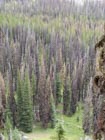
|
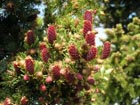
|
|
The species is susceptible to drought, fire, and a variety of pathogens. These trees in the North Cascades of Washington were killed in an extensive bark beetle epidemic that preferentially killed P. engelmannii while sparing associated conifer species. The area experienced a high-severity burn a few years later [C.J. Earle, 2003.08.16]. |
This branch on a tree high in the Medicine Bow Mountains of Wyoming is covered with young, pollen-speckled seed cones and ripe pollen cones [C.J. Earle, 2006.07.01].
|
















